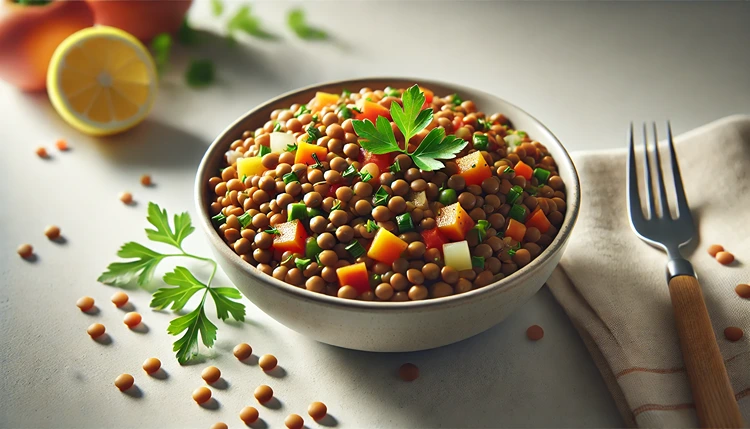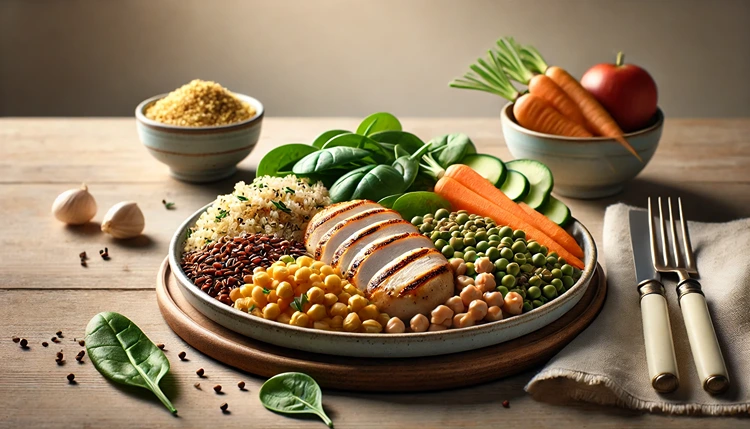Whether you’re new to a gluten-free lifestyle or a seasoned pro, finding gluten-free foods that pack a protein punch can sometimes feel tricky. But don’t worry! There’s a solid lineup of naturally gluten-free, protein-rich foods out there. Knowing where to get your protein without relying on gluten-based products is key, especially if you’re aiming to stay healthy, build muscle, or just keep your energy levels up throughout the day.
In this article, we’ll break down the top gluten-free foods that are high in protein. These choices not only satisfy your dietary needs but are also super versatile in any meal. Ready to learn more? Let’s get started!
Why Is Protein Important in a Gluten-Free Diet?
Protein is essential for your body’s overall function, playing a crucial role in muscle repair, immune system strength, and energy production. Many traditional sources of protein, like bread and cereals, often contain gluten, which can make it a bit tricky for those of us sticking to gluten-free foods to meet our protein needs.
If you’re not careful, a gluten-free diet can sometimes lead to low protein intake, as many gluten-free substitutes lack protein. This is why it’s important to focus on foods that are naturally gluten-free and protein-rich.
What Are the Best Gluten-Free High-Protein Foods?
Let’s take a look at some top gluten-free foods that are high in protein. These options will help you maintain a balanced, nutritious diet without the worry of gluten contamination.
1. Quinoa: The Protein-Packed Superfood
Quinoa is often referred to as a “superfood,” and for good reason. Not only is it gluten-free, but it’s also a complete protein, meaning it contains all nine essential amino acids that your body can’t produce on its own. This makes quinoa a fantastic choice for anyone looking to boost their protein intake.
- Protein content: 8 grams of protein per cup (cooked)
- How to use it: Quinoa is incredibly versatile. Use it in salads, as a side dish, or even as a base for a protein-packed bowl. You can also substitute it for rice or pasta in many dishes.
Helpful Hint:
To boost the protein content of your quinoa meal, consider pairing it with other protein-rich ingredients like black beans or tofu. Not only will this increase the protein, but it also adds texture and flavor to your dish.
2. Lentils

Lentils are another excellent source of protein for those following a gluten-free diet. They’re also rich in fiber and other nutrients, making them a healthy, filling choice.
- Protein content: 18 grams of protein per cup (cooked)
- How to use it: Lentils work well in soups, stews, and salads. You can also use them as a meat substitute in recipes like tacos or spaghetti bolognese.
3. Chickpeas: Versatile and Protein-Rich
Chickpeas are a fantastic gluten-free food that’s high in protein. You can find them in various forms, including whole, roasted, or as the main ingredient in hummus.
- Protein content: 14.5 grams of protein per cup (cooked)
- How to use it: Add chickpeas to salads, roast them for a crunchy snack, or blend them into hummus for a protein-packed dip.
How to Incorporate These Protein-Rich Foods into Your Gluten-Free Diet
Incorporating more protein into your gluten-free diet doesn’t have to be complicated. Here are some tips for using these foods in your daily meals:
1. Start Your Day with Protein
Many breakfast staples contain gluten, but there are plenty of protein-rich, gluten-free alternatives to start your day off right. Consider quinoa porridge or a smoothie with protein-packed ingredients like chia seeds or Greek yogurt (naturally gluten-free, but always check the label).
2. Use Legumes as Meat Substitutes
Legumes like lentils, chickpeas, and black beans are all high in protein and naturally gluten-free. They can easily replace meat in many dishes, helping you stay gluten-free while boosting your protein intake.
3. Opt for Gluten-Free Grains
Grains like quinoa and buckwheat are excellent gluten-free sources of protein. Use them as a base for meals, mix them into salads, or serve them as sides to boost your protein content without relying on gluten-containing foods.
4. Nuts and Seeds: Small but Mighty Protein Sources
Nuts and seeds are excellent gluten-free options that pack a lot of protein into a small package. They are easy to incorporate into meals or enjoy as a quick snack on the go.
- Almonds: 6 grams of protein per ounce (about 23 almonds)
- Pumpkin seeds: 7 grams of protein per ounce
- Chia seeds: 4.7 grams of protein per ounce
These protein-packed seeds and nuts aren’t just great for their protein content—they’re also full of healthy fats, vitamins, and minerals that can help you stay energized throughout the day.
5. Eggs: Simple and Effective
Eggs are a staple in many diets, and they’re naturally gluten-free and protein-rich. Whether scrambled, boiled, or poached, they provide a simple way to up your protein intake.
- Protein content: 6 grams of protein per large egg
- How to use them: Eggs are incredibly versatile. Add them to salads, use them in gluten-free baking, or make them the star of a protein-packed breakfast with a veggie omelet.
Helpful Hint:
For a protein-packed snack, try hard-boiling a few eggs at the beginning of the week. They’re great to grab when you’re in a hurry and need a quick protein boost. Pair them with a handful of nuts for a balanced, gluten-free snack.
6. Greek Yogurt: Creamy and Protein-Rich
If dairy fits into your gluten-free diet, Greek yogurt can be a fantastic source of protein. It’s thicker and creamier than regular yogurt, offering almost double the protein content. Make sure to check the label to ensure it’s gluten-free, as some brands may add thickeners that contain gluten.
- Protein content: 10 grams of protein per 100 grams (plain, unsweetened Greek yogurt)
- How to use it: Eat Greek yogurt as a snack, use it as a base for smoothies, or mix it into your favorite gluten-free baked goods for added moisture and protein.
7. Tofu: A Plant-Based Protein Star
Tofu is a go-to for anyone following a plant-based or vegetarian diet, and it’s a fantastic gluten-free source of protein. Made from soybeans, tofu is incredibly versatile, soaking up the flavors of whatever you cook it with.
- Protein content: 10 grams of protein per 100 grams (firm tofu)
- How to use it: Tofu works well in stir-fries, soups, or even scrambled as a plant-based egg alternative. You can marinate it for extra flavor or use it in salads, wraps, or Buddha bowls.
8. Lean Meats and Poultry: Gluten-Free and High in Protein
For those who eat meat, lean cuts of chicken, turkey, and beef are excellent sources of protein and are naturally gluten-free. Just be sure to check for added sauces or seasonings, which could contain gluten.
- Chicken breast: 31 grams of protein per 100 grams
- Turkey breast: 29 grams of protein per 100 grams
- Beef (lean): 26 grams of protein per 100 grams
These meats are great for meal prep, and you can add them to salads, gluten-free sandwiches, or serve them with gluten-free grains for a balanced, high-protein meal.
How to Build a High-Protein Gluten-Free Meal
Building a high-protein meal on a gluten-free diet doesn’t have to be complicated. Here’s a simple approach to help you get the most protein out of your meals:
1. Start with a Protein Base
Begin your meal with a solid protein source like chicken, tofu, or quinoa. This ensures you’re hitting your protein goals from the start.
2. Add Gluten-Free Grains or Legumes
Next, incorporate protein-rich gluten-free grains like quinoa, or legumes such as lentils or chickpeas. These not only provide additional protein but also offer fiber and other nutrients.
3. Top with Nuts or Seeds
For added crunch and even more protein, sprinkle some almonds, pumpkin seeds, or chia seeds on top of your dish. They also add healthy fats that will help keep you fuller for longer.
Gluten-Free Foods with High Protein Content
| Food | Protein Content (per 100g) | Additional Benefits |
|---|---|---|
| Quinoa | 8 grams | Contains all nine essential amino acids |
| Chicken Breast | 31 grams | Low in fat, high in B vitamins |
| Chickpeas | 19 grams | High in fiber and minerals |
| Tofu | 10 grams | Rich in calcium and iron |
| Salmon | 25 grams | Rich in omega-3 fatty acids |
| Almonds | 21 grams | High in healthy fats and vitamin E |
| Greek Yogurt | 10 grams | Rich in probiotics and calcium |
| Black Beans | 15 grams | Rich in antioxidants and fiber |
What About Protein Supplements on a Gluten-Free Diet?
If you find it difficult to hit your protein goals through whole foods alone, you might consider a gluten-free protein supplement. Many brands now offer gluten-free protein powders made from whey, soy, or pea protein. Just make sure to check the labels for any hidden sources of gluten or cross-contamination warnings.
However, it’s generally best to aim for whole food sources of protein when possible, as these offer additional vitamins, minerals, and fiber that supplements may not provide.
Frequently Asked Questions
Wrapping Up
Eating gluten-free doesn’t mean compromising on your protein intake. With the right knowledge, you can incorporate high-protein, naturally gluten-free foods like quinoa, lentils, eggs, and fish into your daily meals with ease. These foods not only help you stay healthy and energized but also ensure that you meet your dietary needs without relying on gluten-based products. Whether you’re looking to build muscle, stay full longer, or simply maintain a balanced diet, focusing on protein-rich, gluten-free foods is the way to go.

